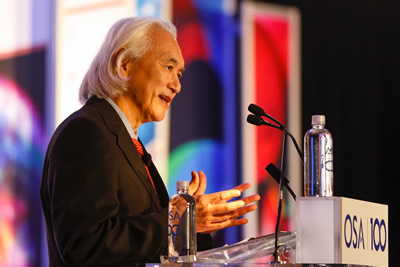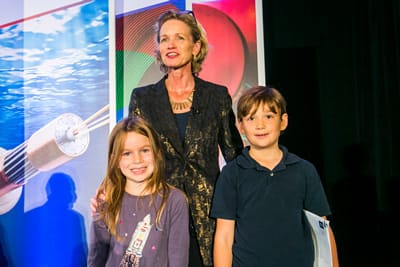The Next Hundred Years of Light: Seeing Far Further into the Universe
The Next Hundred Years of Light: Seeing Far Further into the Universe
Jeff Hecht

Theoretical physicist and futurist, Dr. Michio Kaku, details his predictions for an optically-enabled future at FiO/LS 2016 Light The Future program
100 years ago, Albert Einstein made the prediction of gravitational waves. This year, that prediction was proven by the LIGO Laboratory. Kaku said LIGO is only the start for laser exploration of the universe. "The next step beyond earth-bound gravitational wave detection is to put instruments into outer space," he said. The planned Laser Interferometer Space Antenna (LISA) will have arms three million miles long, and in space vibrations from passing trucks won't obscure gravitational waves. Its size will let LISA detect the cosmos-shaking mergers of million-sun black holes at the centers of galaxies. Future generations will be even more sensitive, with pulsars serving as ultra-precise clocks. "With space-based gravitational wave observatories and pulsar clocks, we can see not just black holes but into the Big Bang itself," he said. "Maybe we will see a picture of an umbilical cord connecting our universe to some earlier universe" — the point at which our universe was born by budding from a predecessor as predicted by the string theory that he helped develop.
Optics may send us to the stars in 20 years, not as humans in the giant spaceships of science fiction but as a fleet of tiny robotic probes the size of postage stamps. The Starshot Project calls for building an 800-gigawatt bank of lasers to accelerate intelligent chips to 20 percent of light speed to reach Proxima Centauri in 20 years. Its sensors and laser transmitters would take snapshots of our nearest neighbor and send them back to Earth.
In the life sciences, the emerging field of optogenetics already uses laser beams to excite opsin proteins in neurons, causing electrical activity at a molecular scale. By encoding viruses with opsin-producing genes and inserting those viruses into brain cells at very specific locations, we can locate neural channels, and cause mice to turn right or left. "This means insight into a whole range of mental diseases, including schizophrenia, depression and Alzheimer's," Kaku says.
Mapping all the neural connections in our brains would record our connectomes, the mental counterparts of our genomes. That recording would characterize us like our genomes. "One possibility is immortality. If you die, your connectome lives on forever," said Kaku, "So one day we could have a library of souls." In a century, a laser beam could send your connectome to Mars in 20 minutes, where it could be uploaded to control a superhuman robot. But that isn't the limit. It is, Kaku said "the most efficient way for an intelligent civilization to explore the galaxy."

Nobel Laureates: William D. Phillips, Nicolaas Bloembergen, Roy J. Glauber, Robert F. Curl, W.E. Moerner, David J. Wineland and John L. Hall
The Laureates saw bright prospects in the nearer term. Much of our modern technology depends on quantum mechanics. But so far our technology has "ignored the weird and wonderful parts, like superposition and entanglement," said 1997 Physics Laureate William Philips. "We are at the beginning of a second quantum mechanical revolution, with technology that depends on those weird and wonderful things, like quantum computers and simulators." David Wineland, 2012 Physics Laureate, echoed him, expecting "good things" from quantum information systems, adding "the real breakthrough will be when we discover some new physics." W. E. Moerner, 2014 Chemistry Laureate, expects new devices to come from new interactions between light and quantum systems. And 2005 Physics Laureate John Hall reminded the packed auditorium "the biggest discoveries come by accident.”
Looking back a century reminds us that the coming century of light will bring both the surprising and the expected. Einstein's prediction of gravitational waves was far-out physics in 1916. The first observations supporting it came only a few later, but direct detection of gravitational waves took 99 years. That detection required more than half a century of refinement to the laser, which itself was an unexpected outgrowth of another 1916 Einstein paper. In the past decade light has made another unexpected discovery of cosmic importance: the universe is full of planets, some of which seem capable of hosting life like ours. In the coming century, light will explore that multitude of planets, and bring us fascinating new discoveries, some expected, and others beyond our imaginations.

Elizabeth Rogan, CEO of The Optical Society, shares the stage with two younger optics enthusiasts

Congresswoman Louise Slaughter (D-NY), Nobel Laureates and University of Rochester East High School students
